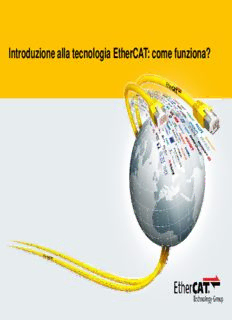
Introduzione alla tecnologia EtherCAT PDF
Preview Introduzione alla tecnologia EtherCAT
Introduzione alla tecnologia EtherCAT: come funziona? Limiti di Ethernet : Utilizzo di banda Ritardi software Ritardi hardware EtherCAT è: Velocità Sincronizzazione Industrial Ethernet Flessibilità Configurabilità Risparmio Implementazione Stabilità Apertura Conformità Sicurezza Opzioni avanzate Versatilità Applicazioni EtherCAT – The Ethernet Fieldbus. Limiti di Ethernet : Ethernet è un’ottima tecnologia – Utilizzo di banda ma è difficile utilizzarla a livello di bus di campo: Ritardi software Configurazione Switch + Router (+ relativi costi) Ritardi hardware Gestione indirizzi MAC e IP EtherCAT è: Router Topologia a Stella Velocità Sincronizzazione Protocolli Complessi Industrial Diagnostica Ethernet Prestazioni Flessibilità Configurabilità Necessarie Risparmio competenze Implementazione IT Stabilità Apertura Conformità Sicurezza Opzioni avanzate Versatilità Applicazioni Introduzione alla tecnologia EtherCAT Ethernet per la comunicazione real-time Limiti di Ethernet : 3 Utilizzo di banda Principali limiti di prestazioni: Ritardi software Ritardi hardware EtherCAT è: Velocità 1. Utilizzazione di banda Sincronizzazione Industrial Ethernet Flessibilità 2C.onfigRuriatbailirtàdi dello stack Risparmio Implementazione Stabilità Apertura 3. Ritardi negli switch Conformità Sicurezza Opzioni avanzate Versatilità Applicazioni Introduzione alla tecnologia EtherCAT 1. Industrial Ethernet Utilizzazione di Banda LiLmiuti dni gEthheernezt z: a minima Frame Ethernet: 84 Byte Utilizzo di banda Esempio: con 4 Byte Process Data (32 I/O): 4/84 = Ritardi software 4.75 % Application Data Ratio Ritardi hardware EtherCAT è: Velocità ≥ 84 Byte, indipendentemente dal protocollo Sincronizzazione Ind1u4s tBriaylte Process Data, es. 1..4 Byte 4 Byte 14 Byte Ethernet Flessibilità FCS Ethernet HDR Process Ethernet Frame Payload: min. 46 Byte Interpacket Gap Configurabilità Data CRC Risparmio Implementazione Stabilità ≥ 84 Byte, es. con Apertura Payload, Con1f4o rBmyitteà 20 Byte 8 Byte 20 Byte es. 4 Byte 4 Byte 14 Byte Sicurezza Opzioni avanzate UDP Ethernet/IP FCS Ethernet HDR IP HDR Process Interpacket Gap Versatilità HDR CIP HDR Data CRC Applicazioni Introduzione alla tecnologia EtherCAT 2. Industrial Ethernet Ritardi dello Stack Limiti di Ethernet : Gli Stack software Industrial Ethernet sono I/O Ports Utilizzo di banda COMPLESSI Ritardi software Device Profile Application Ritardi hardware Objects (e.g. I/O) EtherCAT è: CIP Network & Velocità Transport Sincronizzazione Implicit Explicit MInsdgustrial Msg Ethernet CIP Message EFlnecsaspibsiulitlàation Processarli richiede Configurabilità TEMPO Encapsulation Risparmio TCP UDP Implementazione ISPtabilità Apertura Conformità Ethernet SicuMreAzCza Opzioni avanzate Versatilità Applicazioni Introduzione alla tecnologia EtherCAT 2. Industrial Ethernet Ritardi dello Stack Limiti di Ethernet : EtherCAT è Utilizzo di banda SNELLO Ritardi software Ritardi hardware EtherCAT è: Velocità Sincronizzazione Industrial Ethernet Flessibilità Configurabilità Risparmio Implementazione Stabilità Apertura Conformità Sicurezza Opzioni avanzate Versatilità Applicazioni Introduzione alla tecnologia EtherCAT Confronto performance degli Stack (I) LimLitiedi Epthreernsetta : zioni degli Stack nelle tecnologie Ethernet differiscono Untioliztzeo dvi obalmndaente a causa della diversa complessità degli Stack Ritardi software Softing, uno specialista tedesco nella tecnologia fieldbus, ha pubblicato* Ritardi hardware il seguente confronto tra i ritardi degli Stack: EtherCAT è: Velocità Sincronizzazione Industrial Stack Time Profinet IO Ethernet/IP EtherCAT Ethernet AFvleessribailgitàe 0.58 ms 1.89 ms 0.11 ms Configurabilità Max. 0.74 ms 2.96 ms 0.18 ms Risparmio Min. 0.54 ms 1.23 ms 0.05 ms Implementazione Stabilità Tutti e 3 i protocolli sono stati implementati sullo stesso hardware Apertura (scheda interfaccia con FPGA + Softcore CPU) e dallo stesso team, Conformità quindi sono comparabili Sicurezza Opzioni avanzate Versatilità * Source: „Einer füralle; Flexible Real-Time-Ethernet Anschaltung mitFPGA“, messtecdrives Automation Real-Time Ethernet ASpopnldicearhzeioftn2i010, by Frank Iwanitz, Business Development Manager Real-Time Ethernet at Softing GmbH, Munich, Germany Introduzione alla tecnologia EtherCAT Confronto performance degli Stack (II) LimCiti odi nEtfhreornnett :o tra le prestazioni degli Stack Softing, U+til izBzoedci bkahndoaff EtherCAT Slave Stack Code (SSC*) Ritardi software Ritardi hardware EtherCAT è: EtherCAT (SSC) Velocità Sincronizzazione Industrial Ethernet EtherCAT Flessibilità Min Configurabilità Max Risparmio Average Ethernet/IP Implementazione Stabilità Apertura Profinet IO Conformità Sicurezza Opzioni avanza0te 0,5 1 1,5 2 2,5 3 Versatilità * SSC Stack Delay time measuredon EL9800 EtherCAT Evaluation Kit Applicazioni usingthe10 MHz Serial ProcessData Interface anda 40 MHz 16 Bit PIC CPU; 2 Byte Output Data, min 15µs, max20µs Introduzione alla tecnologia EtherCAT 3. Industrial Ethernet Ritardi degli Switch LiRmiititdai rEdthoer nnete : l buffer dello switch: Utilizzo di banda Non predicibile „per natura“ Ritardi software Ritardi hardware EtherCAT è: Velocità Il ritardo del buffer Sincronizzazione dipende dal carico del Industrial buffer @ arrivo del Ethernet frame. QoS (Quality of Flessibilità Configurabilità Service) allevia Risparmio l‘impatto introducendo Implementazione livelli di priorità (e Stabilità buffer) multipli, ma non Apertura risolve il problema Conformità Sicurezza Opzioni avanzate Versatilità Applicazioni Introduzione alla tecnologia EtherCAT 3. Industrial Ethernet Ritardi degli Switch LiQmitui dai Estih etrunettt :i gli switch usano “Store & Forward” Utilizzo di banda Topologia in linea significa switch in cascata Ritardi software Ritardi hardware EtherCAT è: Consistente ritardo e jitter accumulati anche senza ritardo dei buffer (se gli Velocità switch sono idle). Sincronizzazione Industrial Ethernet Tipico ritardo Store & Forward per switch: Lunghezza frame (7…122µs) + 3µs. Flessibilità Esempio: Frame completo, 20 nodi connessi in topologia lineare: 2,5 ms Configurabilità Risparmio Implementazione Stabilità Apertura Conformità Sicurezza Opzioni avanzate Versatilità Applicazioni Introduzione alla tecnologia EtherCAT
Description: